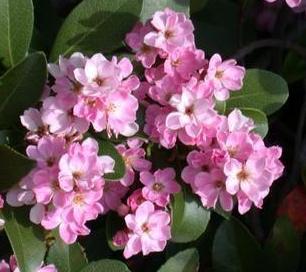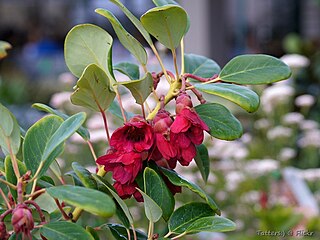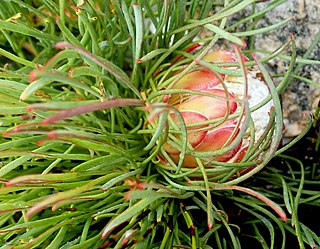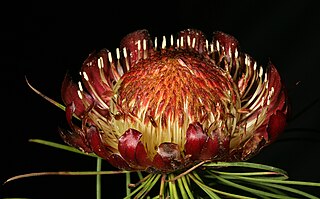
Commelina is a genus of approximately 170 species commonly called dayflowers due to the short lives of their flowers. They are less often known as widow's tears. It is by far the largest genus of its family, Commelinaceae. The Swedish taxonomist Carl Linnaeus of the 18th century named the genus after the two Dutch botanists Jan Commelijn and his nephew Caspar, each representing one of the showy petals of Commelina communis.
Out of the total 1,092 km² of Hong Kong land, three-quarters is countryside, with various landscapes including beaches, woodlands and mountain ranges within the small territory. Most of Hong Kong's parks have natural diversity, usually containing over 1,000 species of plants
Ferrocalamus, or iron bamboo, is a genus of Chinese bamboo in the grass family. endemic to China. The plant is known only from southern Yunnan, at elevations of 900 to 1,200 m above sea level.

Rhaphiolepis indica, the Indian hawthorn, India hawthorn or Hong Kong hawthorn is an evergreen shrub in the family Rosaceae.

Arctostaphylos catalinae, known by the common name Santa Catalina Island manzanita, is a species of manzanita native to Southern California.

Rhodoleia championii, the Hong Kong rose, is a species of plant in the family Hamamelidaceae. It is a small evergreen tree with dangling scarlet flowers that are pollinated primarily by birds, and is found in China, Indonesia, Malaysia, Myanmar and Vietnam.
Buddleja bhutanica is a species of flowering shrub endemic to Bhutan, where it grows in bush on mountain slopes at elevations around 1,700 m. The shrub was first described and named by Yamazaki in 1971.
Buddleja alataRehder & E.H.Wilson is endemic to western Szechuan, China, growing at elevations of 1,300–3,000 m; it was first described and named by Rehder and Wilson in 1913. Leeuwenberg found the plant to be such a perfect intermediate of Buddleja albiflora and Buddleja nivea as to consider it a hybrid of the two species.

Kalidium is a genus of flowering plants in the plant family Amaranthaceae. The species are shrubby halophytes distributed in Southeast Europe, Southwest Asia and Central Asia to China.
Rheum lhasaense is a plant from eastern Tibet belonging to the genus Rheum in family Polygonaceae. It is a mid-sized rhubarb species with triangular leaves and spherical fruit.

Rheum webbianum is a species of herbaceous perennial rhubarb-relative in the family Polygonaceae from the southwestern Himalayan region, known in (Indian) English as Indian rhubarb, Gilgiti rhubarb or small Himalayan rhubarb.

Cecarria is a monotypic genus in the family Loranthaceae. The sole species is Cecarria obtusifolia, a hemiparasitic aerial shrub.

Protea pendula, also known as the nodding sugarbush or arid sugarbush, is a flowering plant of the genus Protea, in the family Proteaceae, which is only found growing in the wild in the Cape Region of South Africa. In the Afrikaans language it is known as knikkopsuikerbossie or ondersteboknopprotea.
Protea intonsa, also known as the tufted sugarbush, is a flowering plant of the genus Protea within the family Proteaceae, endemic to South Africa, where it is distributed from the eastern Swartberg and Kammanassie Mountains to the Baviaanskloof mountains. In Afrikaans it is known as klossie-suikerbos.

Protea montana also known as the Swartberg sugarbush, is a flowering plant of the genus Protea within the family Proteaceae, which is endemic to the southwestern Cape Region of South Africa. In Afrikaans it is known as swartbergsuikerbos.

Protea pityphylla, also known as Ceres sugarbush or mountain rose, is a flowering shrub of the genus Protea, in the family Proteaceae. The plant is endemic to the southwestern Cape Region of South Africa.

Protea canaliculata, also known as the groove-leaf sugarbush, is a species of flowering shrub of the genus Protea, which is endemic to the Cape Provinces of South Africa.
Salix annulifera is a small shrub from the genus of the willow (Salix) with up to 8 centimeter long leaf blades. The natural range of the species is in China.
Salix dissa is a low shrub from the genus willow (Salix) with usually 1 to 3 centimeters long leaf blades. The natural range of the species is in China.
Spathiostemon moniliformis is a plant that can grow as a shrub or a tree in the Euphorbiaceae family, Acalypheae tribe. It is endemic to southern/peninsular Thailand.












